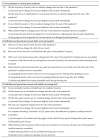Impact of COVID-19 on the Surrounding Environment of Nursing Home Residents and Attitudes towards Infection Control and Oral Health Care among Nursing Home Staff in Japan
- PMID: 36902732
- PMCID: PMC10003858
- DOI: 10.3390/jcm12051944
Impact of COVID-19 on the Surrounding Environment of Nursing Home Residents and Attitudes towards Infection Control and Oral Health Care among Nursing Home Staff in Japan
Abstract
The environments of nursing home staff and residents have dramatically changed since the onset of the COVID-19 pandemic, with greater demand for infection control. This study aimed to clarify the changes and regional differences in the surrounding environment of nursing home residents as well as the working environment of staff, including oral health care, after the spread of SARS-CoV-2. A self-administered questionnaire survey was sent to nursing staff at about 40 nursing homes in different areas of Japan in September and October 2021. The questionnaire consisted of items centered around: (1) the surrounding environment of nursing home residents, (2) awareness and attitudes towards daily work among staff, and (3) attitudes to and procedures for oral health care among staff. A total of 929 respondents included 618 (66.5%) nursing care workers and 134 (14.4%) nurses. Regarding changes in resident daily life, 60% of staff perceived decreases in psychosocial and physical function after the start of the pandemic due to limited family communication and recreational activities, especially in urban areas. Concerning infection control, most respondents adopted routines of disinfecting hands before and after their duties. Oral health care was part of the regular duties of over 80% of respondents. Many participants answered that the frequency and time of oral health care only slightly changed after the onset of COVID-19, but many also reported disinfecting hands both before and after oral health care, particularly in rural areas. Our findings suggested that the COVID-19 pandemic decreased the daily living activities of residents, leading to psychosocial and physical decline, especially in urban areas. The results also indicated that the spread of SARS-CoV-2 triggered improvements in the awareness and attitudes towards infection control in daily work, including oral health care, among nursing care staff, notably in rural areas. Such an effect may contribute to a more positive perception of oral health care infection measures after the pandemic.
Keywords: COVID-19; infection control; nursing home; oral health care.
Conflict of interest statement
The authors have no financial or other kinds of personal conflicts to declare in relation to this work.
Figures
Similar articles
-
Care-home Nurses' responses to the COVID-19 pandemic: Managing ethical conundrums at personal cost: A qualitative study.J Nurs Scholarsh. 2023 Jan;55(1):226-238. doi: 10.1111/jnu.12855. Epub 2022 Dec 4. J Nurs Scholarsh. 2023. PMID: 36464814 Free PMC article.
-
Associations of BNT162b2 vaccination with SARS-CoV-2 infection and hospital admission and death with covid-19 in nursing homes and healthcare workers in Catalonia: prospective cohort study.BMJ. 2021 Aug 18;374:n1868. doi: 10.1136/bmj.n1868. BMJ. 2021. PMID: 34407952 Free PMC article.
-
Nursing home staff attitudes towards residents with dementia: strain and satisfaction with work.J Adv Nurs. 2003 Dec;44(6):583-90. doi: 10.1046/j.0309-2402.2003.02848.x. J Adv Nurs. 2003. PMID: 14651681
-
[Psychosocial effects of the pandemic on staff and residents of nursing homes as well as their relatives-A systematic review].Z Gerontol Geriatr. 2021 Mar;54(2):141-145. doi: 10.1007/s00391-021-01859-x. Epub 2021 Feb 23. Z Gerontol Geriatr. 2021. PMID: 33624143 Free PMC article. German.
-
[COVID-19 outbreak in nursing homes: what can be learned from the literature about other disasters or crisis situations?].Tijdschr Gerontol Geriatr. 2020 Apr 23;51(3). doi: 10.36613/tgg.1875-6832/2020.03.01. Tijdschr Gerontol Geriatr. 2020. PMID: 32951401 Review. Dutch.
Cited by
-
SARS-CoV-2 Infection Among Nursing Home Healthcare Workers: A Longitudinal Study in North-Eastern Italy.Influenza Other Respir Viruses. 2024 Dec;18(12):e70056. doi: 10.1111/irv.70056. Influenza Other Respir Viruses. 2024. PMID: 39702884 Free PMC article.
-
Primary Health Care Case-Management Nurses during the COVID-19 Pandemic: A Qualitative Study.Nurs Rep. 2024 Apr 28;14(2):1119-1128. doi: 10.3390/nursrep14020084. Nurs Rep. 2024. PMID: 38804417 Free PMC article.
References
-
- Abe T., Nofuji Y., Seino S., Hata T., Narita M., Yokoyama Y., Amano H., Kitamura A., Shinkai S., Fujiwara Y. Physical, social, and dietary behavioral changes during the COVID-19 crisis and their effects on functional capacity in older adults. Arch. Gerontol. Geriatr. 2022;101:104708. doi: 10.1016/j.archger.2022.104708. - DOI - PMC - PubMed
-
- Grasselli G., Zangrillo A., Zanella A., Antonelli M., Cabrini L., Castelli A., Cereda D., Coluccello A., Foti G., Fumagalli R., et al. COVID-19 Lombardy ICU Network. Baseline characteristics and outcomes of 1591 patients infected with SARS-CoV-2 admitted to ICUs of the Lombardy region, Italy. JAMA. 2020;323:1574–1581. doi: 10.1001/jama.2020.5394. - DOI - PMC - PubMed
-
- Verity R., Okell L.C., Dorigatti I., Winskill P., Whittaker C., Imai N., Cuomo-Dannenburg G., Thompson H., Walker P.G.T., Fu H., et al. Estimates of the severity of coronavirus disease 2019: A model-based analysis. Lancet Infect. Dis. 2020;20:669–677. doi: 10.1016/S1473-3099(20)30243-7. - DOI - PMC - PubMed
Grants and funding
LinkOut - more resources
Full Text Sources
Miscellaneous


